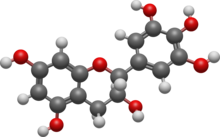 | |
 | |
| Names | |
|---|---|
| Other names (+)-Gallocatechin | |
| Identifiers | |
3D model (JSmol) | |
| ChEBI | |
| ChEMBL | |
| ChemSpider | |
| KEGG | |
| MeSH | Gallocatechol |
PubChem CID | |
| UNII | |
| |
| |
| Properties | |
| C15H14O7 | |
| Molar mass | 306.270 g·mol−1 |
Except where otherwise noted, data are given for materials in their standard state (at 25 °C [77 °F], 100 kPa). | |
Gallocatechol or gallocatechin (GC) is a flavan-3-ol, a type of chemical compound including catechin, with the gallate residue being in an isomeric trans position.
Contents
This compound possesses two epimers. The most common, (+)-gallocatechin (GC), CAS number 970-73-0, is found notably in green tea. The other enantiomer is called (−)-gallocatechin or ent-gallocatechin. It was first isolated from green tea by Michiyo Tsujimura in 1934. [1]
Epigallocatechin is another type of catechin, with the gallate residue being in an isomeric cis position. It can be found in St John's wort. [2]